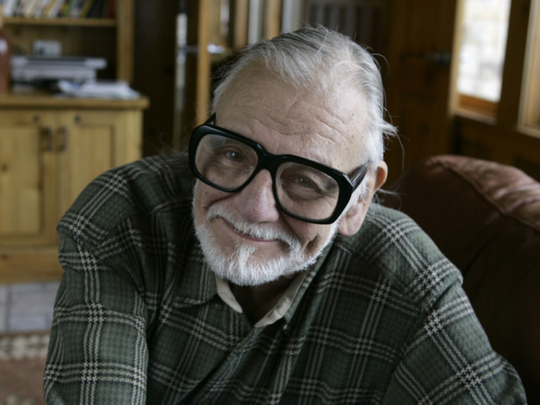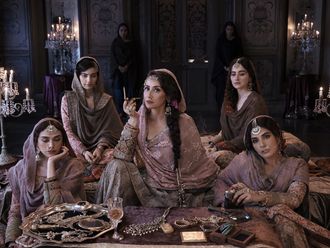
It was the night of April 4, 1968, and George A. Romero was driving to New York City from Pittsburgh on a mission: In the days to come he was to meet with film studios in hopes that one might buy the horror film he was lugging in his trunk, Night of the Flesh Eaters.
None of the studios was interested, but Romero still managed to get his $114,000 (Dh418,623) film in front of audiences that year. And though critics panned the picture, retitled Night of the Living Dead, moviegoers were mesmerised — packing theatres, hitting the drive-ins in droves and making Romero the father of the modern movie zombie. Romero’s Living Dead franchise went on to create a subgenre of horror movie whose influence across the decades has endured, seen in movies such as The Purge and TV shows such as The Walking Dead.
Romero died Sunday in his sleep after a “brief but aggressive battle with lung cancer,” according to a family statement to the Los Angeles Times provided by his longtime producing partner, Peter Grunwald. Romero died while listening to the score of one his favourite films, 1952’s The Quiet Man, with his wife, Suzanne Desrocher Romero, and daughter, Tina Romero, at his side, the family said.
ZOMBIE APOCALYPSE
Romero will be remembered best for co-writing (with John A. Russo) and directing Night of the Living Dead, which showed later generations of filmmakers such as Tobe Hooper and John Carpenter that generating big scares didn’t require big budgets. Living Dead spawned an entire school of zombie knock-offs, and Romero’s own sequels were 1978’s Dawn of the Dead, 1985’s Day of the Dead, 2005’s Land of the Dead, 2007’s Diary of the Dead and 2009’s George A. Romero’s Survival of the Dead.
To get that first film made, however, Romero turned to a resourceful team of Pittsburgh TV-commercial producers. For distribution, the rookie filmmaker turned to the Walter Reade Organization, the parent of Continental Releasing, which specialised in artsy movies such as John Cassavetes’ Faces. The director and his team got 14 prints made, handled their own promotion and opened the picture at 14 local theatres. They financed a world premiere on Halloween night.
Most critics trashed the movie, with Daily Variety citing “unrelieved sadism ... which casts serious aspersions on the integrity of its makers.” But audiences loved it, and drive-in operators took out newspaper ads to apologise for turning away so many customers.
Romero solidified his reputation as a master of the genre with the sequel Dawn of the Dead, which premiered in the US in 1979 and became one of the most profitable independent productions in film history. The franchise would eventually encompass six films — the first four, released decades apart, are one storyline. “Night of the Living Dead, then Dawn of the Dead is a few weeks later, Day of the Dead months later and Land of the Dead is three years later,” Romero said. “Each one spoke about a different decade and was stylistically different. After Land, I wanted to do something about emerging media and citizen journalism.”
CHANGING FACE OF HORROR
Night of the Living Dead evoked Vietnam-era bloodshed and, with its black male lead trapped in a farmhouse, echoed some of the hysteria in the civil rights era. Dawn of the Dead poked fun at soul-deadening consumerism, and Day of the Dead addressed ethics in science. In Land of the Dead, Romero tackled safety and boundaries, showing a community fortifying itself against a murderous horde while its wealthiest citizens keep alive class divisions.
But part of what made Romero’s films so distinctive, no doubt, was their unbridled gore, which caused many of the movies to go unrated.
In a 2010 interview with the Times, he said: “Hard-core horror fans would like to see more and more of it. It’s the fun part.”
George Andrew Romero was born in the Bronx in New York City on February 4, 1940. He attended Carnegie Mellon University in Pittsburgh, graduating in 1961. He stayed in Pittsburgh for much of his feature film career.
In the years immediately after Night of the Living Dead, he made films that were less popular, including 1971’s There’s Always Vanilla, 1973’s The Crazies and 1978’s Martin.
Between other Dead films he directed the 1981 film Knightriders starring Ed Harris, the 1988 movie Monkey Shines (first studio-produced film, which introduced him to Grunwald) and Two Evil Eyes, a 1990 horror film he made with Italian filmmaker Dario Argento inspired by Edgar Allan Poe short stories. His last credit as a writer was for his characters’ appearance in 2017’s Day of the Dead from director Hector Hernandez Vicens.
The movies and TV shows that have taken their cues from Romero’s work — World War Z, 28 Days Later, Shaun of the Dead — seem almost too numerous to count. And though the popularity of something such as The Walking Dead would seem to be a compliment to Romero, he once called that juggernaut “a soap opera with a zombie occasionally”.
“I always used the zombie as a character for satire or a political criticism, and I find that missing in what’s happening now,” he said in 2013.
Romero is survived by his wife, his daughter, his son Andrew Romero and, from his earlier marriage to Christine Romero, his son Cam Romero.












